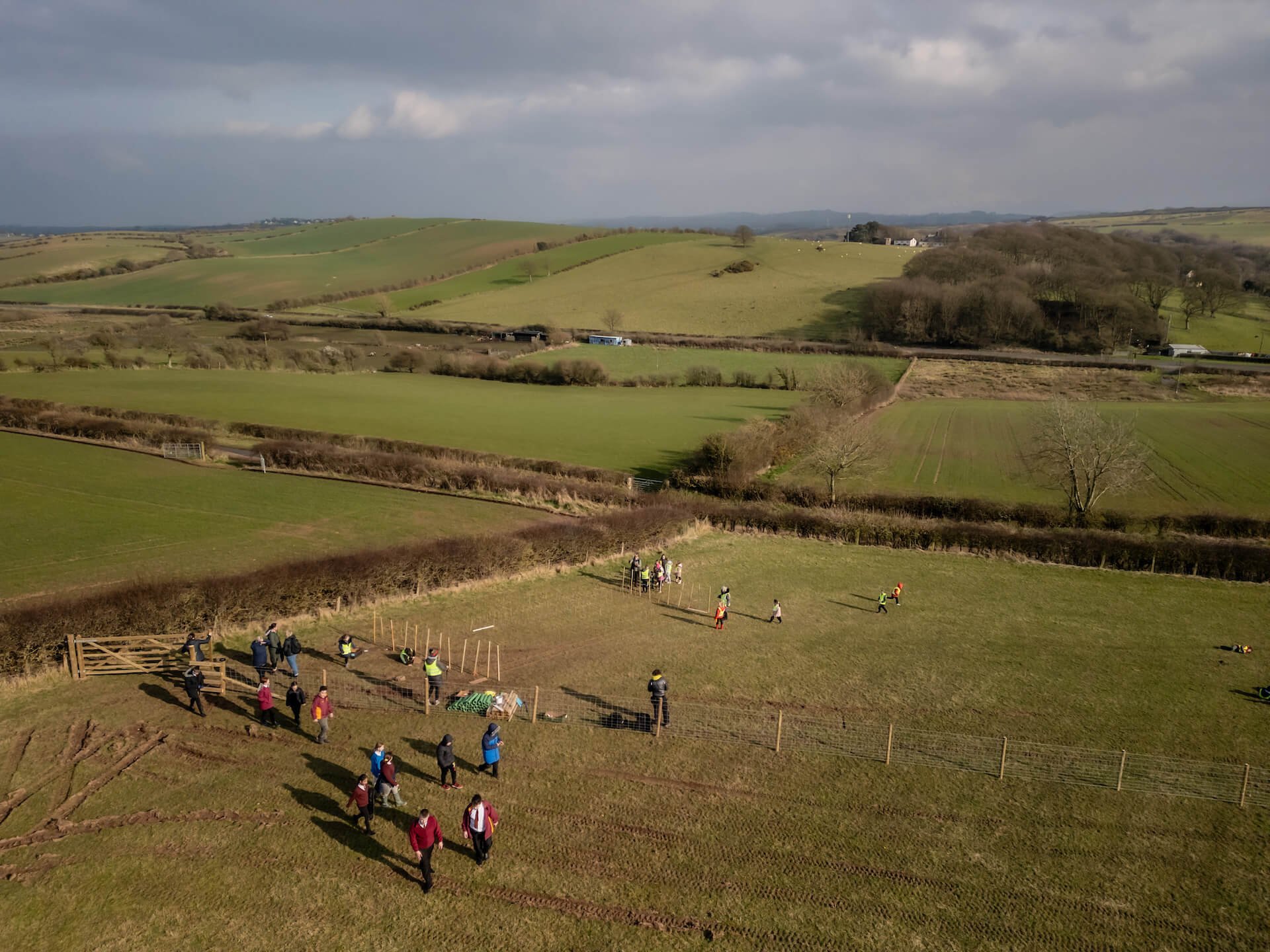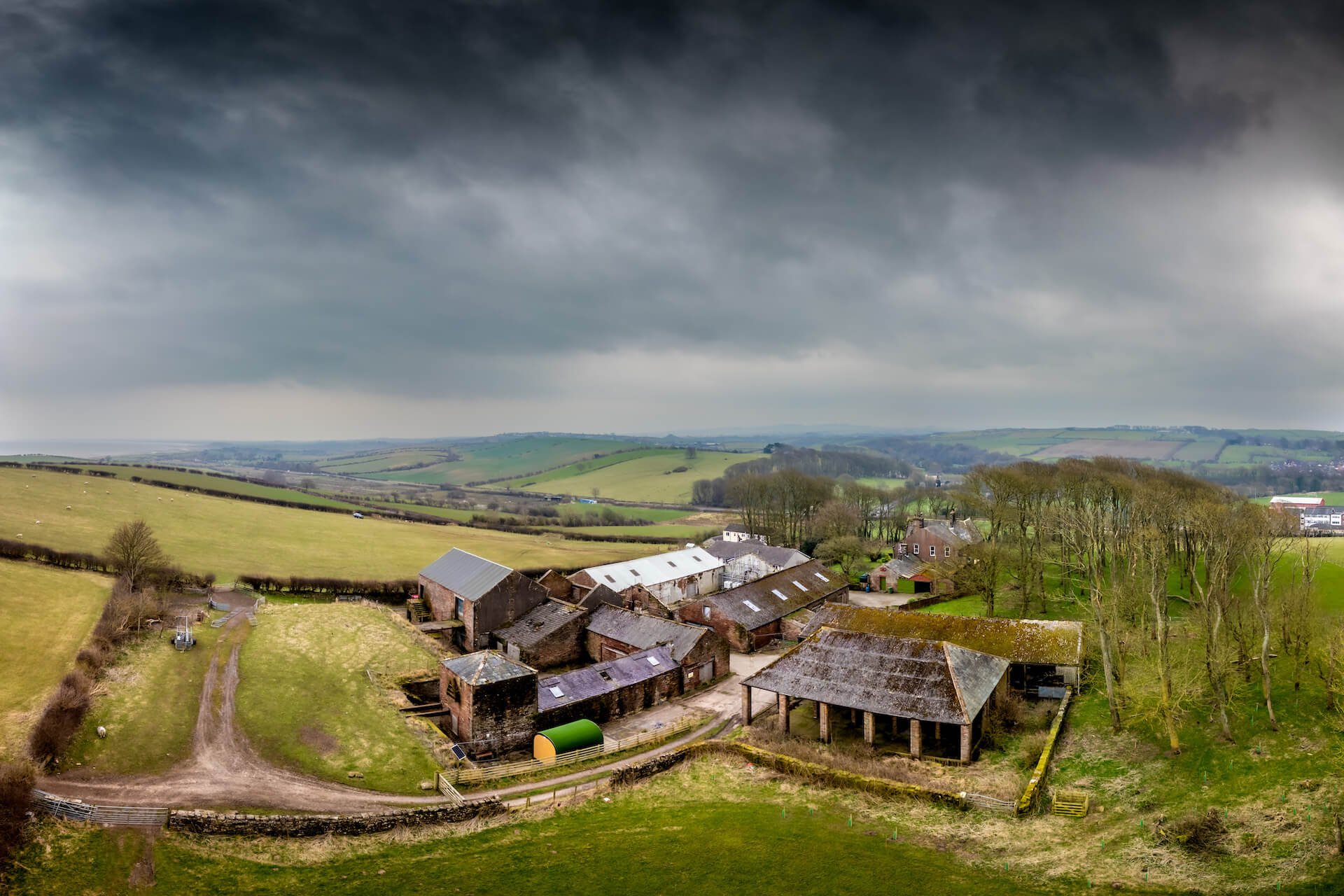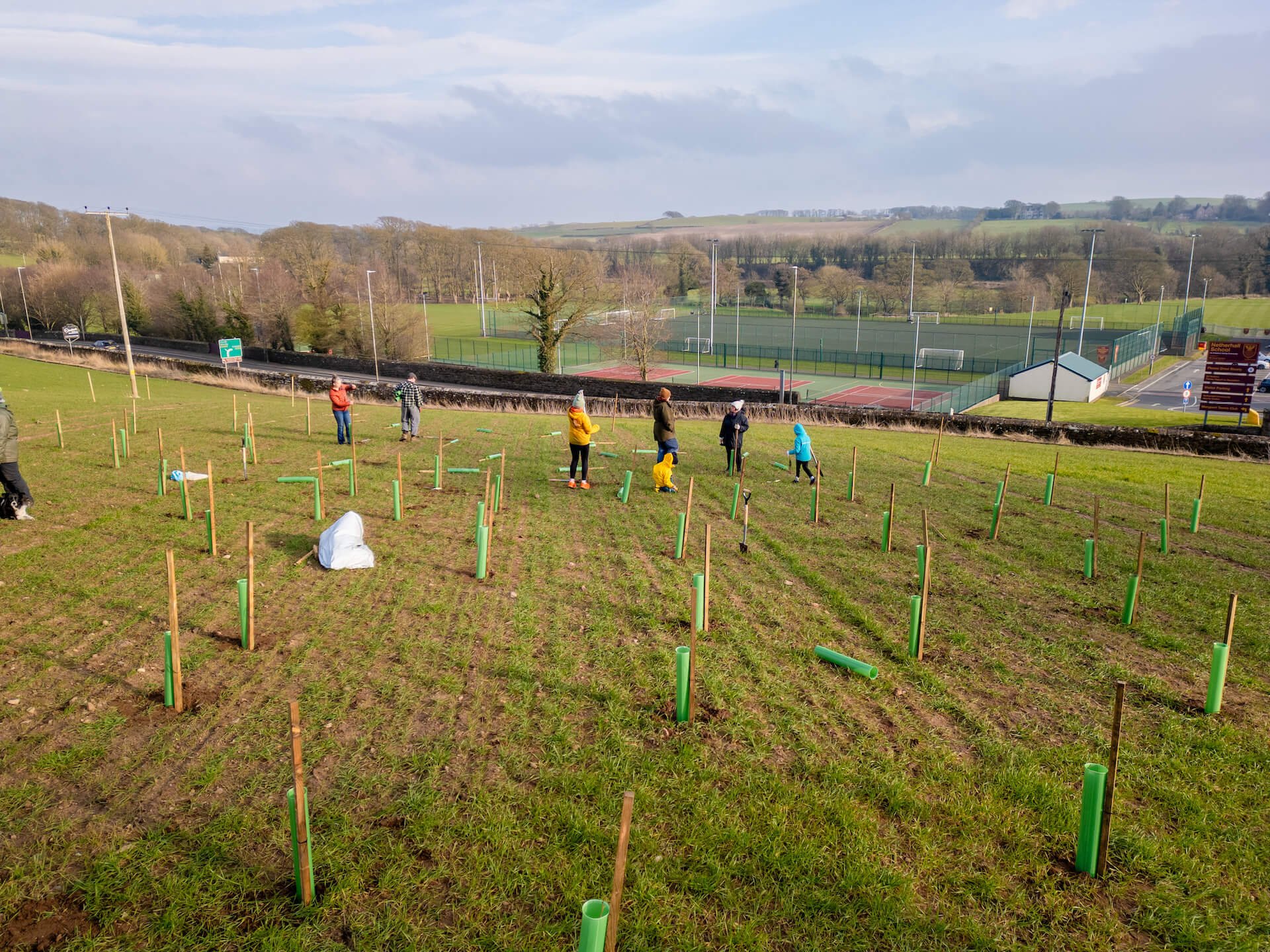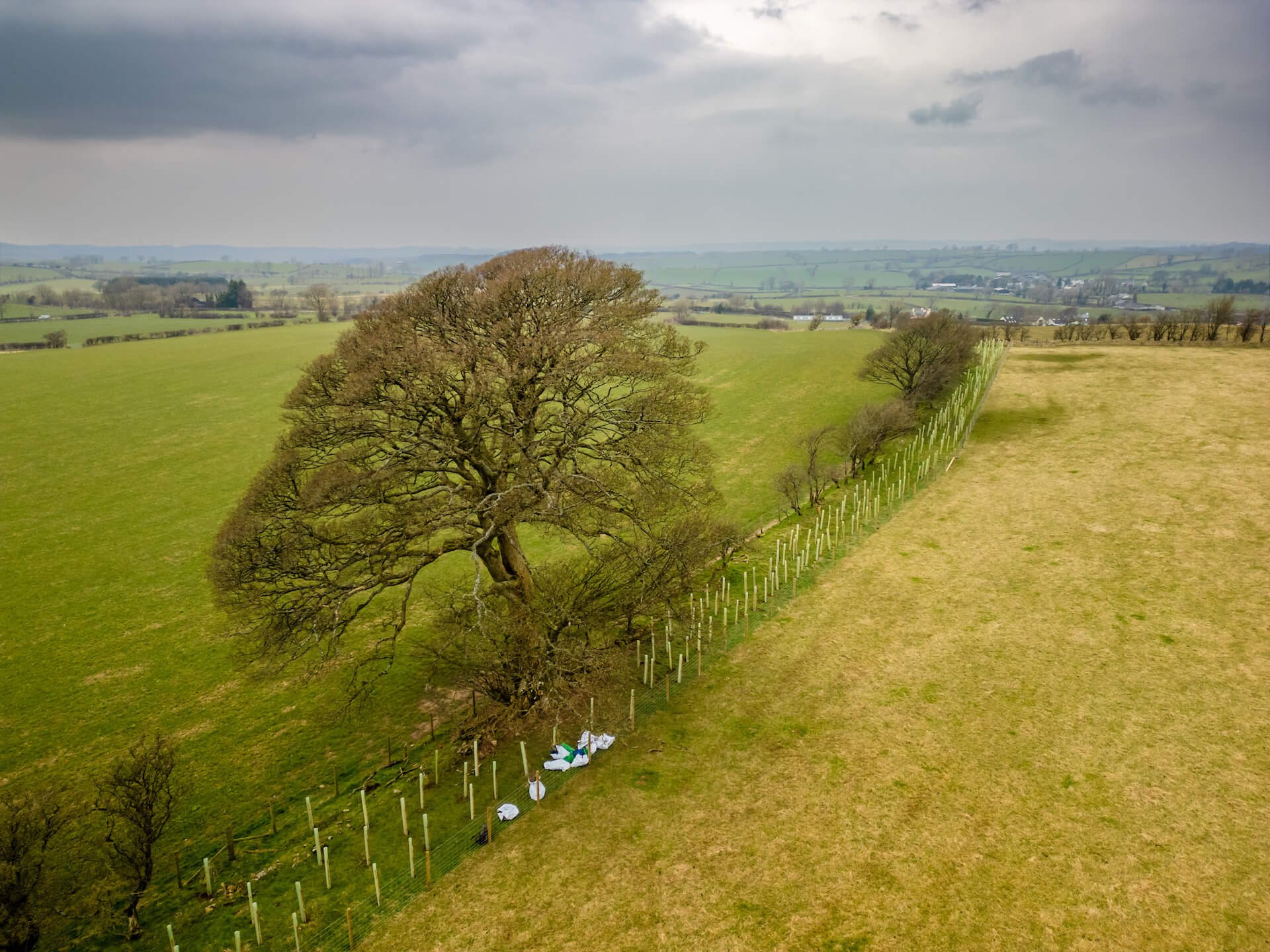Forest Plan / Evidence / Opportunity Mapping

Opportunity Mapping
This Forest Plan is informed by expert geospatial analysis, provided by consultants Crossbill Forestry [20]. Their modelling presents a detailed picture of the opportunities and constraints together with indicative targets for woodland establishment within the boundary of Cumbria Community Forest (CCF).
Within the CCF boundary, areas of denser population, lower woodland cover and socio-economic inequity are linked from the west coast of Cumbria inland to Carlisle. This boundary was informed by Government statistics on relative deprivation in England, focusing the heart of the forest around the post-industrial towns of Cumbria, where investment in regeneration could bring large benefits to the communities living there. The CCF boundary extends into the surrounding rural landscape where further land suitability and benefits of investment in treescapes are anticipated.
Given its origin, the forest boundary does not fit neatly with established geographic nor administrative boundaries. Furthermore, the suitability of land for woodland establishment needed to be considered along with the potential benefits from addressing deprivation and inequity. Detailed analysis of the opportunities within the CCF boundary to achieve our desired outcomes [T] was therefore required. Raise continues to explore opportunities to address the suitability of the CCF boundary with key stakeholders in a phased, partnership approach.
[T] “We plant trees to improve the environment and address the climate crisis, whilst creating social and economic opportunities to improve health and wellbeing.” Raise (2024) About us. Available at: https://www.raisecumbria.co.uk/about-us

Developing the Spatial Model
The aim of the digital model developed for Cumbria Community Forest was to identify where there are opportunities to sustainably increase woodland cover, and where tree establishment or woodland creation would have a positive impact on:
- Social, economic, and health and wellbeing outcomes;
- Biodiversity; and
- Flood mitigation and water quality.
The modelling process, in summary, comprised the following steps:
- Data indicating constraints to woodland creation were collated.
- Data detailing potential areas of opportunity were collated.
- Constraints and opportunities data were combined to produce a ‘heatmap’ of woodland creation opportunity.
- The resultant heatmap was summarised on a hexagon grid within the CCF boundary.
Overall woodland creation opportunity in each hexagon on the heatmap is categorised 'Low’ to ‘High’ in 5 increments, indicated by colour intensity – the darker the hexagon, the higher opportunity identified.
Incorporating Defra’s legally binding woodland cover target for England (to reach 16.5% by 2050) and existing woodland cover in Cumbria (12.9% within the CCF boundary at March 2024) the difference of 3.6% was distributed across the 5 opportunity categories on a weighted basis, leading to indicative targets for establishment of new woodland as a percentage of land area in each hexagon.
Geospatial Analysis
The input data, gathered from multiple reliable data sources as detailed in Table 1, is collated into three composite data layers:
- Unplantable
- Environmental opportunities
- Social opportunities
These layers are combined to produce the heatmap of woodland creation opportunity. Further detail on the analysis undertaken to select and combine source data and to attribute scoring and heatmap opportunity categories is provided in the Crossbill Forestry (2024) report [21].
Table 1: Input data for data layers in CCF geospatial model
| Composite data layer | Description of input data |
|---|---|
| Unplantable | Existing features which preclude woodland creation such as surface water, existing buildings and roads, land allocated for housing, scheduled ancient monuments and non-woodland priority habitats such as deep peatland. |
| Environmental Opportunities | Indicators of environmental opportunities where woodland establishment may connect existing woodland, decrease flood risk and/or enhance key habitats (the latter using Wood Pasture Network Enhancement and Ancient Woodland Network Enhancement data from Natural England). |
| Social Opportunities | Indicators of social opportunities where woodland establishment may deliver social benefits such as access to nature-rich greenspace close to home [U], improved air quality and other public health benefits (using data on health and economic deprivation from the Office for National Statistics). |
[U] Based on the 15-minute access ambition of Defra’s Environmental Improvement Plan (2023) and existing public rights of way data

Modelling Principles
Principles of credibility, legitimacy and saliency [22] are central to our opportunity mapping as shown in Table 2, below.
Table 2: Raise: CCF geospatial modelling principles
| Principle | What is it? | How have we enacted this principle? |
|---|---|---|
| Credibility | Perceived techincal soundness of the model | Used independent GIS consultancy; multiple robust and verifiable data sources; sought guidance and scrutiny from relevant GIS experts, e.g. Local Nature Recovery Strategy Spatial Planning group, Natural England and England's Community Forests network. |
| Legitimacy | Validity of the model to the context of our forest area | Sought and gained on an ongoing basis via the involvement of key stakeholders including local government, other CCF partners, CCF funders, local community link organisations, landowners, farmers, tree and woodland specialists. |
| Saliency | Accessibility and relevance of the model outputs to stakeholders | Presenting visual heatmap output and key annotations via stakeholder meetings and community interactions; interactive presentation via our website.
Integrating the model into the everyday workings of CCF delivery: informing our identification of new woodland creation projects and bespoke community engagement for each site; channelling associated funding. |
Opportunity heatmap and its use
Figure 13 is an image of our opportunity ‘heatmap’ for Cumbria Community Forest, as at March 2025.
An Interactive Map is also available on our website, with guidance for using and interpreting it. It shows the most current opportunity mapping, along with sites that have already been planted by Raise: Cumbria Community Forest.
Figure 13: Tree Opportunity Heatmap for Cumbria Community Forest provided by Crossbill Forestry, 2024
Interpreting the heatmap
The heatmap displays relative opportunity for establishing trees within the Cumbria Community Forest boundary.
Darker colour indicates greater opportunity.
Opportunity categories take account of unplantable land, benefits to people and benefits to the environment.
Opportunity is averaged across each hexagon
Hexagon colour does not indicate that everywhere in the hexagon is equally suitable for planting.
This map informs our tree establishment target for each hexagon.
These targets range from 0-1% of the ‘plantable’ land area in the Low opportunity (lightest) hexagons to 6-9% of the ‘plantable’ land area in the High opportunity (darkest) hexagons.
Farmland has not been designated unplantable in our mapping.
This leaves our funding routes open for agroforestry and other farm-specific tree planting opportunities including hedgerows and orchards
Farmers and landowners can work with us by choice, we don't have authority over land use.
How we use the heat map
The heatmap provides information to aid decision-making.
This helps the Raise team to direct funding and prioritise our support.
We aim to develop the community forest soonest in the areas of greatest positive impact.
Suitability is always checked locally on a site-by-site basis.
Due to multiple land uses and their benefits within each hexagon, it is not our aim for all the land in any given hexagon to become forested.
Click the images below to view each region in more detail:

Outputs
The geospatial analysis has supplied:
- Confirmation that there is significant opportunity for tree establishment within the CCF boundary.
- Knowledge that relative woodland creation opportunity varies across the CCF boundary, and “a strong case for targeting planting purely based on relative opportunity" (Crossbill Forestry, 2024).
- Indicative woodland establishment targets which enable us to retain flexibility whilst steering woodland creation activity, at landscape scale, towards areas where the potential to achieve the CCF’s strategic objectives is greatest. These targets range from 0-1% of the land area in the ‘Low’ opportunity category hexagons to 6-9% of the land area in the ‘High’ opportunity category hexagons.
When applied to the whole of Cumbria, the geospatial analysis also confirms high levels of opportunity around Penrith and Kendal.
In addition to the heatmap, our interactive map displays further detail of the landscape features within each hexagon which contribute to opportunity and constraints. This data helps the Raise team and other interested parties to identify opportunities for woodland creation, for example to link existing woodland.
Strengths and Limitations
Strengths of the model are:
- the bespoke, place-based approach;
- our commitment to the modelling principles of credibility, legitimacy and saliency as discussed above;
- technical expertise and local knowledge of Crossbill Forestry;
- our collaborative approach incorporating data and feedback from stakeholders.
Limitations to the geospatial modelling are recognised and addressed in Table 3.
Table 3: Limitations to Geospatial Modelling for Cumbria Community Forest (CCF), and their mitigations
| Limitation | Mitigation |
|---|---|
Assumptions about unplantable land
|
|
Input data validity
|
|
Model interpretation
|
|
Targets and deliverables
|
|

[20] Crossbill Forestry (2024) Geospatial analysis to inform the Cumbria Community Forest’s 25-year strategic plan; and Executive Summary of Geospatial analysis to inform the Cumbria Community Forest’s 25-year strategic plan.
[21] Crossbill Forestry (2024) Geospatial analysis to inform the Cumbria Community Forest’s 25-year strategic plan.
[22] Informed by: Cash et al. (2002) Salience, Credibility, Legitimacy and Boundaries: Linking Research, Assessment and Decision Making. Available at: https://papers.ssrn.com/sol3/papers.cfm?abstract_id=372280; Hamilton et al. (2010) A framework for characterising and evaluating the effectiveness of environmental modelling. Available at: https://doi.org/10.1016/j.envsoft.2019.04.008; Luisiana et al. (2011) Users' perspectives on validity of a simulation model for natural resource management. Available at: http://dx.doi.org/10.1080/14735903.2011.582362








